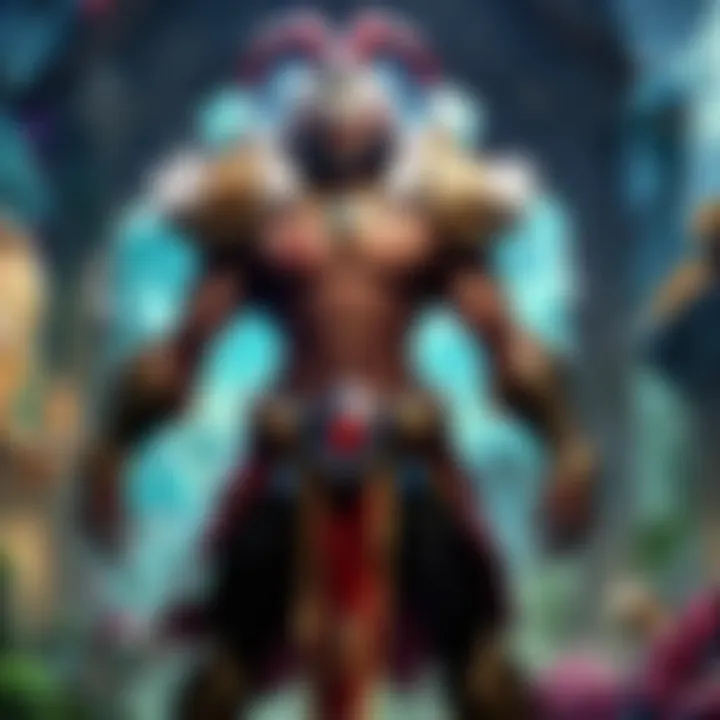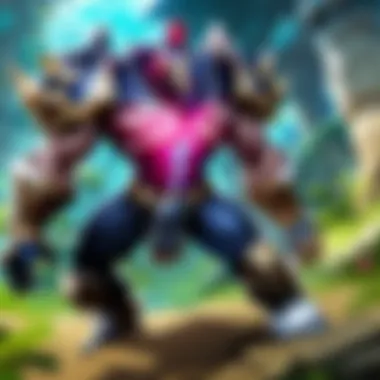League of Legends on iPhone: A Deep Dive into Mobile Play


Intro
The world of mobile gaming continues to expand at a rapid pace, and League of Legends on iPhone stands as a testament to this trend. The game has managed to carve a niche of its own among casual and competitive gamers alike, who are seeking to experience the rich landscapes of the League universe on-the-go. With its intricate mechanics and engaging gameplay, it's fascinating to explore how the game translates to mobile devices, particularly the iPhone.
This article embarks on a comprehensive journey through its features, performance nuances, and effects on the mobile gaming ecosystem. From its roots on PC to the intricacies of gameplay adapted for touch controls, each aspect will be scrutinized. Community feedback and technical specifications also shape our understanding, culminating in a discussion on how this adaptation stacks up against its desktop counterpart.
In this exploration, we will also peek into the future of League of Legends on mobile platforms. The enthusiasm surrounding this adaptation is palpable, not just among avid gamers, but also within the broader gaming community, eager for what lies ahead. Let's dive right into the nitty-gritty of the champions themselves, highlighting who stands out in this adaptation.
Champion Spotlights
New Champion Spotlight
As League of Legends continues to evolve, so too do its champions. The launch of a new champion can invigorate the game’s meta and gameplay style. On the iPhone platform, these new entrants bring fresh dynamics that players must quickly adapt to. For example, we can take a closer look at the newly released champion, Zeri. As a speedster in the game, she presents unique challenges and opportunities for players navigating touch controls.
Her abilities require precise timing and positioning, particularly when it comes to dodging skill shots or coordinating quick movements. The effortless blend of speed and skill creates an exhilarating gameplay experience on mobile. Here’s why players need to pay attention:
- Ability Adaptation: Understanding ability cooldowns is crucial in executing combos effectively on a touch screen.
- Positioning: Mobile players must be nimble, requiring a different approach to spatial awareness than when playing on PC.
Champion Builds and Strategies
Finding effective builds for champions is just as vital as mastering their abilities. On iPhone, this means simplifying strategies into digestible chunks that resonate with on-the-go play. The crux of success lies in understanding key items and synergies.
For instance, a champion like Darius can benefit from specific items that bolster his damage and survivability:
- Goredrinker: Essential for its healing properties especially in prolonged fights.
- Sterak’s Gage: To increase durability during team fights.
Utilizing a streamlined build helps players focus on executing strategies in the heat of battle, rather than becoming bogged down by decision fatigue.
Gameplay Tips and Strategies
Early Game Tactics
Mastering the early game on the iPhone involves quick thinking and even quicker reactions. Players should consider:
- Minion Management: Controlling the lane by last-hitting minions while preventing opponents from doing the same.
- Warding Wisely: Using the warding trinket effectively can help avoid early ganks.
Team Fighting Strategies
When the clock strikes the mid-game, team fights become the focal point of gameplay. Coordination here is essential. Within the mobile format, players must:
- Communicate Effectively: Use preset commands to signal intentions swiftly.
- Focus Fire: Prioritizing targets can be the difference between victory and defeat.
Patch Updates
Patch Notes Analysis
Staying up-to-date with patch notes ensures players are aware of any nerfs or buffs that could swing the balance of power among champions. Recent changes, for instance, to The Conqueror rune have impacted numerous champions across both iPhone and PC platforms.
Meta Shifts
The game’s meta is in constant flux, and the mobile version is no different. Players must adapt to shifting strategies that other players are employing, ensuring their skill sets evolve as the game progresses.
Community News
Esports Coverage
The competitive scene remains a hot topic within the community, especially with major tournaments being broadcast for mobile users. Following these events can provide insights into the current state of mobile LoL.
Community Spotlight
Many grassroots initiatives are underway, fostering connections among players. Local tournaments and online challenges pave ways for participation, enhancing engagement in the community.
Bonus Content
Lore Exploration
The richness of League of Legends lore cannot be overstated. With each champion having their backstory, players may find themselves more drawn to their characters.
Fan Creations


The creativity of the community is astounding, with fan art and videos celebrating both champions and gameplay. Exploring these creations not only adds depth to the League experience but also connects players globally.
"Understanding the nuances of gameplay and community dynamics shapes our experience deeply. The lore and champion backgrounds complement the strategic aspect seamlessly."
Preface to League of Legends on Mobile Devices
In recent years, the landscape of gaming has undergone a seismic shift, primarily driven by the rise of mobile devices. This section explores the significance of League of Legends on mobile platforms, particularly the iPhone. The importance of mobile adaptations lies not only in accessibility but also in expanding the player base, allowing individuals who might not have desktop setups to dive into the vibrant world of Summoner’s Rift.
As mobile technology has advanced, game developers have seized the opportunity to bring complex gaming experiences to the palm of players' hands. This transition is not merely about simplifying graphics or controls; it's about reimagining gameplay. League of Legends, originally a PC titan, faces unique challenges on mobile, including how to effectively deliver intense real-time strategy elements in a more compact format.
Players benefit immensely from mobile adaptations. The ability to engage in competitive matches while on the go promotes flexibility and spontaneity in the gaming experience. With League of Legends on iPhone, players can compete in intense battles without being tied to a single location.
However, this mobile incarnation requires careful consideration of various elements:
- Touch Control Dynamics: Translating precise mouse movements and keyboard shortcuts into touch inputs is not a trivial task. Game developers must find creative solutions to maintain the game's competitive nature without sacrificing usability.
- Graphic Performance: Achieving optimal graphics that can run smoothly on mobile devices is both a technical challenge and a creative endeavor. iPhones are powerful, but they still require optimization to deliver an engaging visual experience without overheating or draining battery life.
- Community Engagement: The multiplayer essence of League of Legends on mobile means that fostering a positive community is essential. The difference in player behavior when shifting from PC to mobile is worth investigating.
This leads us to the next subsection.
The Evolution of Mobile Gaming
The evolution of mobile gaming has been nothing short of extraordinary. What began with simple pixelated games has grown into a multi-faceted industry where complex titles thrive. This transformation is characterized by increased processing power, advanced graphical capabilities, and the overall consumer shift towards mobile technology over traditional consoles.
Initially, mobile gaming was often dismissed as casual fare, but as smartphones began to dominate, developers started crafting intricate gaming experiences. Success stories such as Candy Crush and Fortnite paved the way for strategies to cater to sophisticated gamers. With these benchmarks established, bringing League of Legends to mobile was the natural next step.
The development of mobile gaming is also tied closely to internet accessibility. Fast data networks allow for real-time multiplayer interactions, which is crucial for games like League of Legends. Players can team up with friends or join global matches seamlessly, regardless of location.
"The rise of mobile gaming has democratized access to gaming; anyone with a smartphone can dive into a world of engaging content."
With portability and accessibility at the forefront, the mobile gaming experience has evolved into something that is not only game-changing but potentially life-altering for many gamers.
Historical Context of League of Legends
League of Legends debuted in 2009, quickly asserting itself as a cornerstone of the multiplayer online battle arena genre. Developed by Riot Games, its popularity surged due to its strategic gameplay and evolving meta. The game carved out a niche in esports, evolving into a global phenomenon with tournaments that fill stadiums and attract millions of viewers.
However, as mobile platforms gained traction, players began to express interest in experiencing the League of Legends they loved on their phones. Recognizing this demand, Riot Games announced plans for a mobile version, ultimately resulting in the launch of League of Legends: Wild Rift.
This evolved version has distilled the essence of its predecessor into a format suitable for mobile play, maintaining key elements such as champion skills and map dynamics while simplifying others to suit touch controls. This careful balancing act has been pivotal to its acceptance in the gaming community.
Adapting League of Legends for iPhone
This section is pivotal to understand the nuances of transitioning a complex PC game like League of Legends onto the iPhone. With the increasing prominence of mobile gaming, adapting League of Legends ensures that loyal players can engage with their beloved game on-the-go. The process carries numerous benefits and challenges, from interface design to gameplay mechanics, all tailored for the limited yet versatile capabilities of an iPhone.
Interface Design Considerations
Touch Controls
The introduction of touch controls marks a significant change in how players interact with League of Legends on mobile. Unlike traditional setups that utilize a mouse and keyboard, touch controls allow for direct manipulation of characters and abilities on-screen. This aspect enhances accessibility, bringing the game to a broader audience who may not own a gaming PC but have a capable smartphone.
A standout feature of touch controls is their intuitive nature. Players can tap, swipe, and drag with ease. For example, the ability to quickly tap on the minimap to engage an enemy or retreat provides a fluid experience. However, these controls can feel clunky for seasoned players used to the precision of a mouse. Often, executing skill shots and managing multiple abilities can expose a learning curve that might deter some.
Screen Layout
Screen layout significantly influences how the game is perceived and played on an iPhone, providing a tailored experience that blends functionality with aesthetics. An essential characteristic of a successful screen layout is the prioritization of vital game elements, such as the health bars, minimap, and ability icons. Ensuring they’re easily accessible is paramount for maintaining engagement during frantic matches.
One unique feature of the screen layout is the streamlined UI that resets the game's visual hierarchy. This design choice aims to minimize distractions, allowing players to focus on their strategy rather than hunting down necessary controls. However, as beneficial as this might be, some players might find the compressed layout constraining, making it challenging to react swiftly during high-stakes moments in the game.
Gameplay Mechanics for Mobile
Skill Execution
Skill execution on mobile devices demands an entirely different approach compared to PC gaming. The benefit of straightforward access through touch controls is countered by the precision often required in executing abilities. Mobile gameplay focuses on simplifying complex mechanics without sacrificing the essence of strategic depth.
Game developers put considerable thought into simplifying the execution of skills while ensuring that the competitive spirit remains intact. For instance, automatic targeting helps new players ease into the more complex strategies, allowing veterans to enjoy the same thrill they experience on PC. Still, many traditional players find that the reduced control can affect their overall performance, leading to frustrations in competitive play.
Character Movement
Character movement stands as a cornerstone of gameplay mechanics in any MOBA, and this remains critical on iPhone as well. On mobile, characters can be guided with a virtual joystick or touch gestures, introducing new dynamics to how players navigate the map.
A notable aspect of character movement is its adaptive nature to touch inputs. It brings an element of fluidity that can be both exhilarating and infuriating. Many players enjoy the freedom this gives, allowing for swift dodges or strategic repositioning during battles. However, mis-taps while trying to make quick directional changes can lead to unintended actions, which often open the door to in-game misfortunes. The balance between freedom and control is delicate, requiring practice and adaptability from players.
Performance Factors of League of Legends on iPhone


The performance factors of League of Legends on iPhone are crucial for both casual and competitive gamers. This section zeroes in on the elements that define a smooth gaming experience on mobile devices, ensuring that players enjoy the game's rich features without hitches. Optimization is not just about making the game look good; it's about how the game plays, how responsive the controls are, and how well the device handles network challenges.
Graphics Optimization
In the landscape of mobile gaming, graphics optimization plays a vital role in how a game is perceived. When it comes to League of Legends on iPhone, the balance between appealing visuals and smooth performance is paramount. The developers have tailored the game's graphic settings to provide high-quality graphics while not straining the device's hardware. This is especially important for intense team battles where clarity and detail can make the difference between victory and defeat.
Benefits of Graphics Optimization:
- Enhanced Visual Clarity: High-definition graphics allow players to spot champions, abilities, and minions more easily.
- Frame Rate Stability: Ensuring a stable frame rate, particularly during heavy action scenes, avoids the dreaded lag that can ruin gameplay.
- Adjustable Settings: Players have options to tweak settings to favor performance over visuals, accommodating various iPhone models.
Mobile gamers tend to appreciate vivid graphics, but not at the expense of performance. Striking the right balance is key. The game employs adaptive techniques that change the graphical output based on current device capabilities, ensuring consistent performance. The resulting effect is an engaging visual environment that retains League of Legends' iconic style without sacrificing playability.
Network Latency and Connectivity
For any online game, network latency can be a dealbreaker, and League of Legends on iPhone is no exception. Latency refers to the time delay in transmitting data between the player's device and the game server. High latency can lead to lag, causing delays between a player's actions and the game's response, which might be fatal during competitive play.
- Factors Affecting Latency:
- Wi-Fi vs. Cellular Data: Generally, Wi-Fi connections provide a more steady experience. Cellular data quality can fluctuate based on network congestion, which can adversely affect gameplay.
- Server Location: The distance to the nearest game server also influences connection quality. Players should be aware of their server assignments.
- Device Performance: The iPhone's internal resources can impact its ability to process network data quickly, making optimization necessary.
Minimizing latency involves several steps. Players are encouraged to use a strong Wi-Fi connection whenever possible. Additionally, leveraging tools, such as network performance monitoring apps, can help diagnose issues affecting gameplay. Ultimately, understanding and mitigating network factors empowers players to focus on strategy without worrying about connectivity issues.
"In the fast-paced world of competitive gaming, even milliseconds count; being aware of connectivity can make all the difference in the heat of battle."
By addressing both graphics optimization and network connectivity, League of Legends on iPhone offers a robust mobile experience tailored to the needs of today's gamers.
Reception Among Players
The reception of League of Legends on iPhone holds considerable weight in understanding how its adaptation resonates with the mobile gaming community. Feedback from players not only reflects their enjoyment but also gives insight into the strengths and weaknesses of this mobile version compared to its desktop counterpart. As the gaming industry continues to expand into mobile territories, this reception plays a pivotal role in shaping future developments and updates.
Community Feedback
Positive Aspects
One of the shining lights in community feedback is the simplicity of getting into the game. Players have noted that League of Legends on iPhone has made gaming more accessible, as it's no longer tied strictly to a computer setup. The portability allows players to jump into matches whenever, wherever. This organization practically amplifies the game's social dynamics, letting friends squad up on short notice.
A key characteristic that many praise is the smooth integration of touch controls, achieving a high degree of precision that some mobile titles struggle to deliver. This aspect caters not just to veterans who are already familiar with the mechanics, but also to newcomers who can find their footing a bit easier. Benifits include:
- High Accessibility: Players appreciate being able to game on the go.
- Real-Time Connectivity: The capability to log in anytime supports an agile social environment.
However, there are niggling issues, particularly around the virtual joystick. Many players express that persistent use can lead to discomfort during extended gaming sessions. This bit of feedback is noteworthy as it signals room for improvement, causing teams to think about ergonomic changes in future updates.
Critiques and Concerns
On the flip side, some players have raised critiques and concerns about the overall performance and experience on iPhone. One major concern is related to networking issues. Users have noted instances of lag or disconnects during critical game moments, which detracts from the otherwise engaging gameplay. This concern resonates strongly, especially within the competitive scene where moments can decide a game's outcome.
Another issue is the daunting learning curve for complete newcomers. Despite the game's intuitive touch controls, the depth and complexity of League of Legends still require effort and investment to master. Some newcomers might find themselves overwhelmed by tactics, champion selection, and map familiarity when transitioning to the mobile platform. Unique features contributing to these concerns include:
- Latency in Critical Moments: Lag can be fatal during intense games, impairing performance.
- Steep Learning Curve: The core game mechanics can be daunting if not approached with commitment.
Comparative Analysis with PC Version
The contrast between League of Legends on iPhone and its PC version gives a clearer view of its strengths and limitations, enhancing our understanding of player reception as well.
Gameplay Experience
When it comes to gameplay experience, a notable factor is how well the tactical alternative translates from the keyboard and mouse to touch controls. Players have remarked on a distinct sensation of fluidity while playing on mobile, though it doesn’t fully replicate the precision of desktop controls. The ability to make quick decisions and moves is still there, but players have occasionally expressed that it can feel somewhat clunky when compared side-by-side with the PC gameplay.
The overall competitiveness is still intact, although players have pointed out that strategic planning and execution demand a bit more patience when managing touch controls. Benefits include:
- Portability: The chance to play on the go is unmatched.
- Casual Gameplay: Ideal for relaxed matchups, making it appealing for newcomers or casual gamers.
Visual Differences
Visual differences between the two platforms come into play more significantly than one might think. The iPhone version, while visually striking, displays some compromises regarding graphical fidelity in comparison to its PC counterpart. Mobile players find that certain detail levels are lowered, especially during action-heavy moments. This leads to some minor challenges in strategy as visual cues are less pronounced compared to PC, influencing decision-making processes during gameplay.
However, the intuitive touch interface can balance this aspect somewhat and helps keep the immersion. Unique visual features in the mobile version allow for a different yet engaging experience:
- Adaptive Graphics: Visual scaling based on device capabilities enhances performance on various iPhones.
- Touch-Oriented UI: The layout is purposely designed for quick access, boosting the gameplay fluidity despite some losses in detail.


"The mobile experience is not just a shrunken copy of the desktop. It has its own rhythm and flow, which can sometimes outshine the original in the hands of a skilled player."
Balancing pros and cons, player reception provides invaluable insights into the feasibility of League of Legends on iPhones, offering a diverse perspective on its impact in today’s mobile gaming landscape.
Strategies for Efficient Mobile Gameplay
Playing League of Legends on iPhone is a different beast compared to its PC counterpart. The transition from a desktop with all its might to a handheld device necessitates a sea change in strategies. An adept mobile gamer knows that success isn’t just about reflexes; it’s also about smart decisions and adjustments tailored for the mobile environment. In this section, we will dig into essential strategies that enhance your gameplay experience.
Adjusting Settings for Performance
First on the list is adjusting settings for performance—quite frankly, this can make or break your gaming experience. Mobile devices, despite sounding like superheroes with their powerful processors, aren’t always as capable as PCs. Players should navigate to the game settings and tweak performance options accordingly. This includes lowering the graphics quality to reduce lag and improve framerate, making critical moments more manageable.
- Graphics settings: Reducing textures and effects can lead to smoother gameplay, especially in team fights where visual clutter occurs.
- Frame Rate: Adjusting to a lower frame rate can lessen the demand on your device. Some people might scoff at this, but in the heat of battle, a couple of extra frames can mean life or death.
- Touch Sensitivity: Altering touch sensitivity in settings helps dots a player’s finger accurately hit targets without stray inputs, which often lead to unwanted movements.
The ease of accessing these settings is a boon; however, a player must take time to tailor them to their device’s capabilities. Remember, a well-optimized device allows for a more fluid experience, ultimately improving your kill-to-death ratio.
Choosing the Right Champions
Next up is the consideration of champion selection. While each champion brings their unique flair to the battlefield, not every champion is suited for mobile mastery. Some champions with intricate combos and high skill ceilings often force players into a quagmire, especially on a smaller screen where quick taps are essential.
- Emphasis on Simplicity: Champions like Garen or Ashe, who have straightforward mechanics, are easier for new players to pick up and play on mobile, thus reducing the learning curve on screen.
- Consider Roles and Positioning: Understanding your team's needs is crucial. Sometimes it’s about filling roles, while at others, it’s about complementing your team's strengths. For example, if your teammates are picking late-game-focused champs, opting for a jungler like Lee Sin could create tempo advantages early.
- Adaptability: In mobile scenarios, prioritize champions that can adapt to various situations, like Janna who provides shields and crowd control but doesn’t require constant micromanaging.
In essence, carefully choosing champions can drastically affect your overall gameplay efficiency. Players should prioritize understanding their champions and which ones deliver the most impact, rather than simply picking their favorite.
Navigating in Competitive Play
Lastly, let’s explore navigating in competitive play. The landscape of competitive gaming on mobile is ever-evolving, especially for League of Legends. Players need a strategy that considers teamwork, communication, and leveraging the unique features of mobile gaming.
- Team Coordination: Ensuring that all teammates are aware of the game plan, roles, and expected behavior in various phases is essential. Whether it's executing ganking strategies or grouping for objectives, coordination is key.
- Communication Tools: Use in-game communication tools effectively, ensuring that everyone is on the same page. Using quick replies can streamline interactions and maintain focus.
- Adapting to Touch Controls: Developing the skill to maneuver effectively using touch inputs without compromising on gameplay is crucial. This can mean adjusting movements and combat in ways that feel less intuitive but are more effective
Playing mobile League of Legends with the right mindset can elevate one’s game. Understanding the nuances that present themselves on a smaller device often determines who walks away victorious or defeated in the arena.
"Mastery of mobile play isn’t simply about speed; it’s about rhythm and making harmony between what the device provides and what the game demands."
In summary, employing these strategies can greatly enhance the mobile gameplay experience, laying the groundwork for not only individual improvement but also overall team success.
Future Developments for League of Legends on iPhone
As mobile gaming technology advances, exploring future developments for League of Legends on the iPhone becomes essential. This aspect not only highlights the ongoing improvements that players can expect but also shines a light on the broader horizon of mobile gaming.
In particular, focusing on potential enhancements and evolving esports trends will underline the commitment to maintaining a competitive edge in an ever-changing market. Understanding these developments can empower players to stay ahead of the curve, adapting their strategies to benefit from new features and gameplay dynamics.
Potential Feature Enhancements
Feature enhancements are pivotal for enhancing the overall League of Legends experience on iPhone. These upgrades might include:
- New Game Modes: Exploring options like casual play or special events tailored for mobile. These modes could provide fresh challenges for seasoned gamers while enticing newer players.
- Customization Options: As players invest time in their champions, personalizing skins or abilities could increase player satisfaction. In-game rewards for achieving milestones could add layers of motivation.
- Improved Social Features: Better integration with platforms such as Reddit and Facebook could also foster community engagement. Players could enjoy sharing tips, forming teams, or hosting tournaments, adding more depth to the experience.
- Augmented Reality (AR) Features: AR could bring an interactive layer to the game, allowing players to see champions in their real-world environment. This immersive experience might create a buzz and draw in more players.
The development of these features hinges on technological innovation and player demand, ensuring that the game remains responsive to its active community's aspirations. Mobile technology continues to evolve, transforming our expectations of what's possible.
Evolving Trends in Mobile Esports
The esports landscape is rapidly shifting, and mobile platforms like the iPhone are now holding their own in this arena. Understanding these evolving trends is crucial for players and developers alike. Here are some noteworthy trends:
- Emergence of Mobile Tournaments: Esports is no longer confined to PCs. Mobile tournaments are gaining traction, with significant prize pools and popular platforms, showcasing the potential of League of Legends on the iPhone.
- Streamlined Viewing Experiences: Innovations aimed at enhancing spectator experiences on mobile devices could attract a wider audience. Features that allow seamless viewing of matches, including in-game stats and commentary, can add to the overall excitement.
- Sponsorship and Branding Opportunities: As mobile esports grow, so does interest from sponsors. Collaborations with brands could lead to enriched in-game experiences and promotional events, providing players with additional resources and recognition.
- Diverse Player Base: With a rising number of casual gamers picking up their phones to play, League of Legends on iPhone has the opportunity to harness this diverse audience. This infusion of players can lead to a richer gameplay environment, where veteran players and newcomers engage with one another.
Ending
In the fast-paced landscape of mobile gaming, League of Legends on iPhone stands out as a remarkable adaptation of a beloved PC classic. This section ties together the threads discussed throughout the article, emphasizing not only the transformative journey of League of Legends from a PC environment to a mobile one, but also its significance for both gamers and the broader industry.
Summarizing Key Insights
When considering the evolution of mobile gaming, it’s crucial to recognize how League of Legends has managed to retain its core gameplay while tweaking specific elements to fit the mobile sphere. Players appreciate the effective interface design that simplifies complex maneuvers without sacrificing depth. Some key insights include:
- Touch Control Adaptations: The intuitive touch controls have opened the door for new players who might find traditional keyboard setups daunting.
- Network Performance: The game's performance on the iPhone highlights the importance of stable connectivity, ensuring that latency issues do not disrupt the immersive experience.
- Community Reception: Feedback from players shows that, while there are critiques, the majority of the community acknowledges the effort put into optimizing the game for mobile devices.
With these elements in mind, it’s clear that the iPhone version serves more than just a portable experience; it creates an inclusive space for gamers who previously couldn't engage with the title.
The iPhone's Role in League of Legends' Future
Looking forward, the iPhone is poised to play a crucial role in shaping the future of League of Legends. As technology continues to evolve, so will the game's features and functionalities. Some potential trajectories include:
- Integration of Augmented Reality (AR): As AR technology becomes more mainstream, integrating it within the game might offer players even more engaging experiences on mobile.
- Enhanced Cross-Platform Play: Improved cross-platform capabilities could further blur the lines between mobile and PC, allowing players to compete and communicate seamlessly regardless of their device.
- Increased Esports Focus: The growth of mobile esports cannot be ignored. With events specifically tailored for mobile versions, the iPhone could bring new talent into the spotlight, offering fresh opportunities for competitive play.
In summary, the transition of League of Legends to the iPhone is not just an adaptation; it represents a pivotal moment in the convergence of mobile and traditional gaming platforms. As players navigate this new landscape, the insights and strategies discussed can serve as a foundation for future success, making the iPhone a key player in the ongoing saga of League of Legends.
"The future of gaming is not just in the arenas, but also in the palms of our hands, making every player a potential champion."





